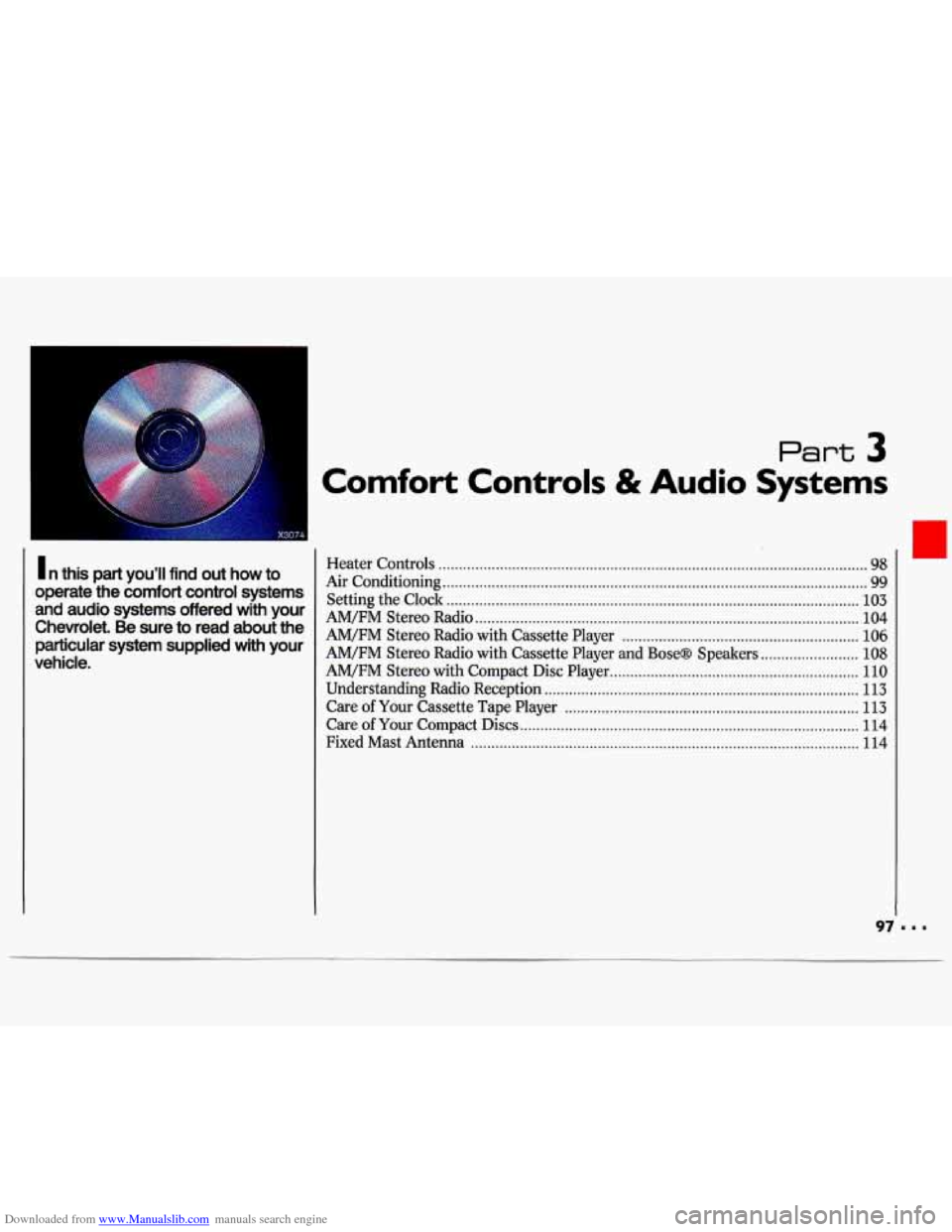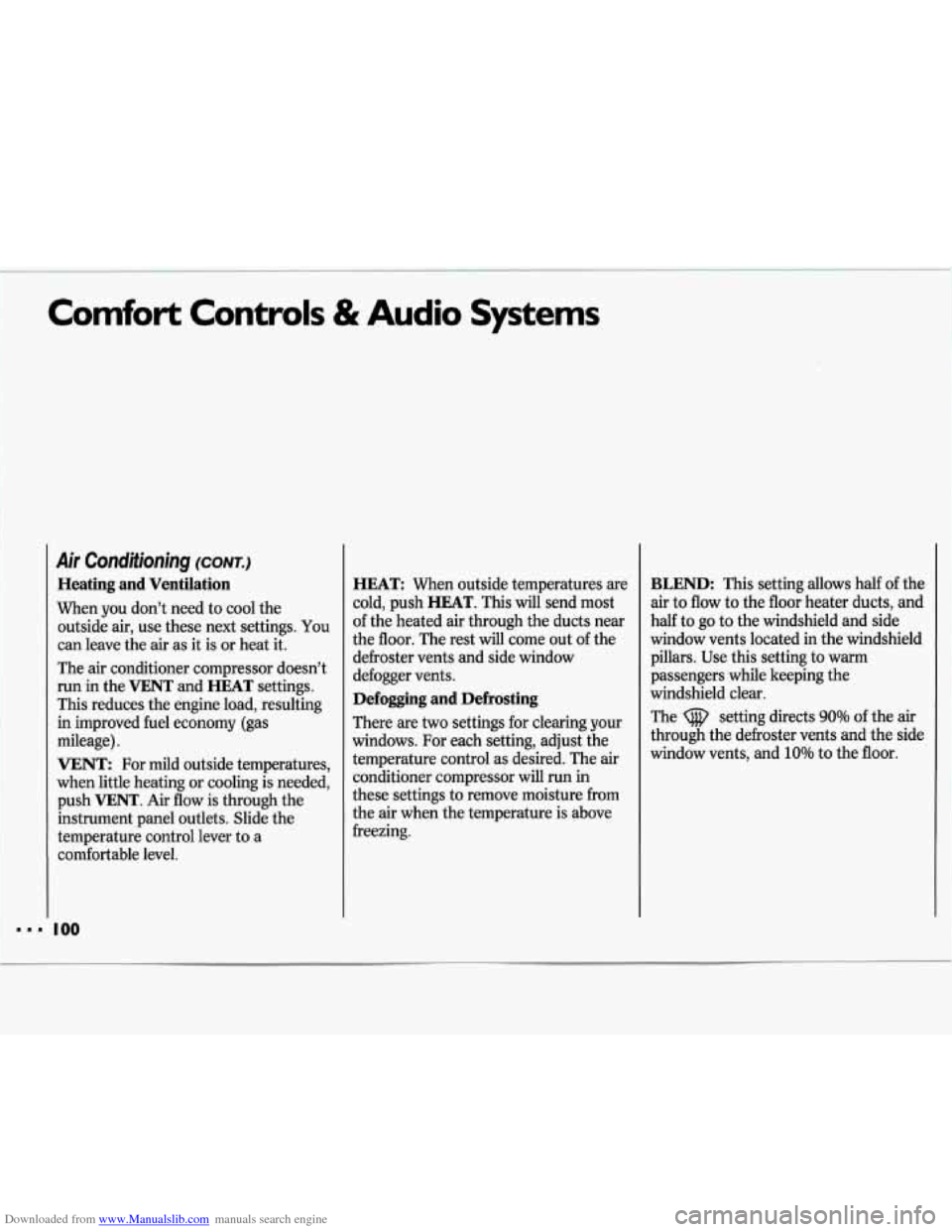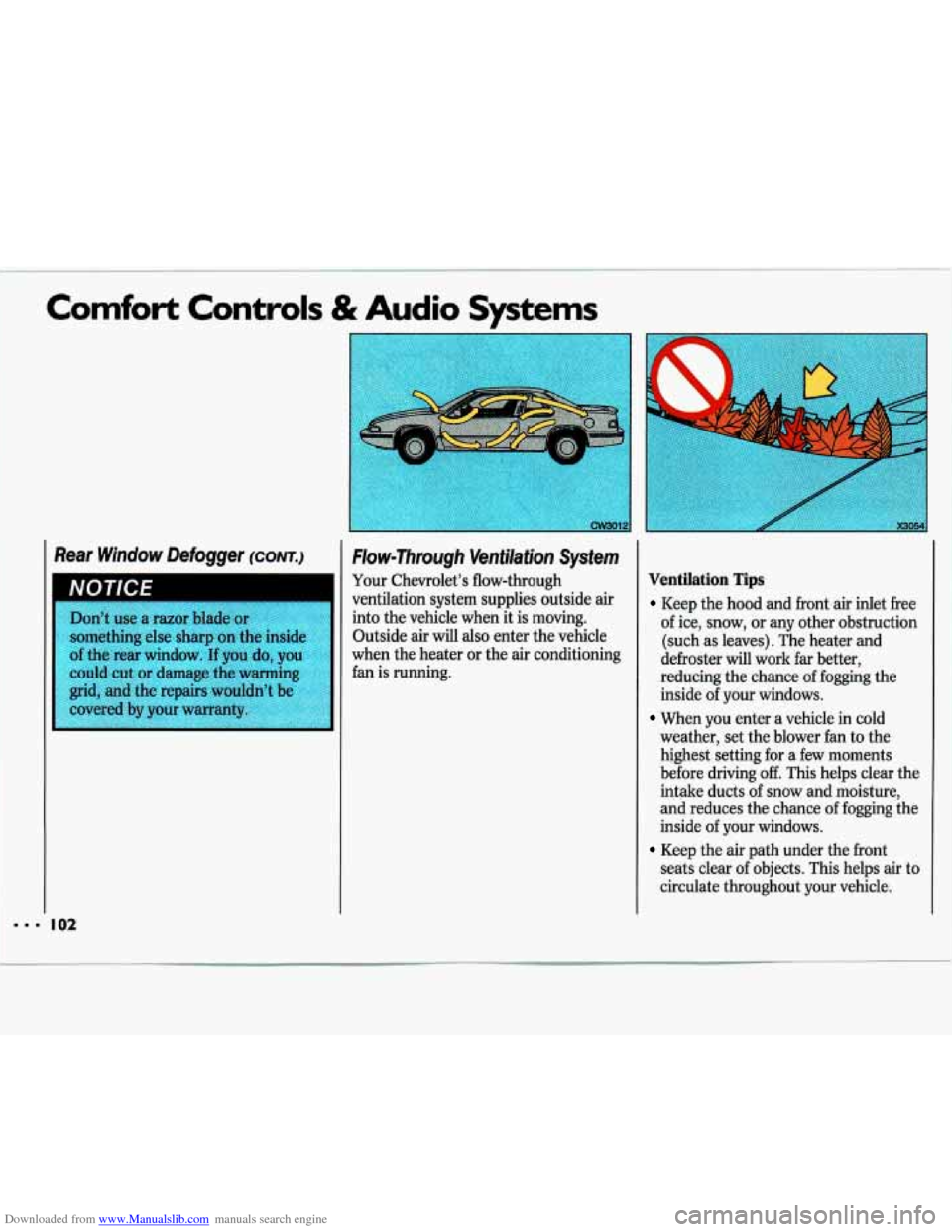1993 CHEVROLET LUMINA audio
[x] Cancel search: audioPage 3 of 324

Downloaded from www.Manualslib.com manuals search engine 0 Chevrolet Lumina I993 Owner’s Nanual
Table of Contents
Printed in USA
Part 2
Part 3
Part 4
Part 5
Part 6
Introduction How to Use this Manual ........................
Part I Seats & Safety Belts ............................ 11
Features & Controls ............................. 45
Comfort Controls & Audio Systems. ... 97
Your Driving and the Road ................ 117
Problems on the Road ....................... ’ 163
Service & Appearance Care .............. 191
Part 7
Part 8
Part 9
Maintenance Schedule ...................... 259
Customer Assistance Information mm.. 281
Includes “Reporting Safety Defects” on page 286
Service Station Information .... Last Page
101 93599 6 Second Printing ...
Page 8 of 324

Downloaded from www.Manualslib.com manuals search engine How to Use this Manual
', !. -7 ': ,
Using Your 1993 Chevrolet
Owner's Manual
Many people read their owner's manual
from beginning to end when they first
receive their new vehicle. This will help
you learn about the features and
controls for your vehicle. In this
manual, you'll find that pictures and
words work together to explain things
quickly.
There are nine parts with color-tabbed pages in this manual. Each part begins
with a brief list of contents,
so you can
usually tell at a glance
if that part
contains the information you want.
You can bend the manual slightly to
reveal the color tabs that help you find a
part.
6
Part 1: Seats and Safety Belts
This part tells you how to use your seats
and safety belts properly.
Part 2: Features & Controls
This part explains how to start and
operate your Chevrolet.
Part 3: Comfort Controls & Audio
Systems
This part tells you how to adjust the
ventilation and comfort controls and
how
to operate your audio system.
Part 4: Your Driving and the Road
Here you'll find helpful information and
tips about the road and how to drive
under different conditions.
Part 5: Problems on the Road
This part tells you what to do if you
have a problem while driving, such as a
flat tire or engine overheating.
Part 6: Service & Appearance Care
Here the manual tells you how to keep
your Chevrolet running properly and looking good.
Part 7: Maintenance Schedule
This part tells you when to perform
vehicle maintenance and what fluids and lubricants to use.
Part 8: Customer Assistance
Information
This part tells you how to contact
Chevrolet for assistance and how to get
service publications. It also gives you
information on
Reporting Safety Defects.
Part 9: Index
Here's an alphabetical listing of almost
every subject in this manual. You can
use it to quickly find something you
want to read.
Service Station Information
This is a quick reference of service
information. You can find it on the last
page of this manual.
Page 87 of 324

Downloaded from www.Manualslib.com manuals search engine The Instrument Panel-
Your Information System
Your instrument panel is designed to let
you know at
a glance how your vehicle
is running. You’ll know how fast you’re
going, how much. fuel you’re using, and
many other things you’ll need to drive
safely and economically.
The main components
of your
instrument panel are:
1. Vents
2. Turn SignaVHeadlight Beam Lever
3. Tilt Steering Wheel Lever
4. Instrument Cluster
5. Hazard Warning Flashers Switch
6. Vents
7. Climate ControWRear Window
8. Vents
9. Vents Defogger
10. Glove
BodFuse Panel
11. Audio System
12. Gearshift Lever
13. Ashtray and Lighter
14. Ignition Switch
15. Horn
16. Remote Trunk Release (Option)
17. Brake Release
18. Light Controls
19. Hood Release (on floor by driver’s
door)
Page 99 of 324

Downloaded from www.Manualslib.com manuals search engine 1 n this part you’ll find out how to
operate the comfort control systems and audio systems offered with your
Chevrolet
. Be sure to read about the
particular system supplied with your
vehicle
.
Heater Controls ........................................................................\
................................. 98
Air Conditioning ........................................................................\
................................ 99
Setting the Clock ........................................................................\
............................. 103
AM/FM Stereo Radio
........................................................................\
...................... 104
AM/FM Stereo Radio with Cassette Player
.......................................................... 106
AM/FM Stereo Radio with Cassette Player and BoseB Speakers ........................ 108
AM/FM Stereo with Compact Disc Player
............................................................. 110
Understanding Radio Reception
........................................................................\
..... 113
Care of Your Cassette Tape Player ........................................................................\
113
Care of Your Compact Discs ........................................................................\
........... 114
Fixed Mast Antenna ........................................................................\
....................... 114
Page 100 of 324

Downloaded from www.Manualslib.com manuals search engine Comfort Controls & Audio Systems
Heater Controls
OFF: Press to turn the system off.
Some air will still come from the
outlets at the floor. Press any function
button to turn the system on.
Temperature Control Lever: This
lever changes the temperature
of the
air coming through the system. The
farther the lever is to the right, the
warmer the air.
8: Selects the force of air you want.
Press
V to lower the fan speed, A to
raise it.
Heating and Ventilation
There are three settings to heat and
ventilate your vehicle. For each setting,
set the temperature control lever to a
comfortable setting.
HEAT: Press to direct heated air
through the heater ducts. Some heated
air will also come through the
windshield defroster vents.
BI-LEV: Use on cool, but sunny days.
This setting brings in the outside air,
but directs it in two ways. The cool air is directed to the upper portion of your
body through the instrument panel
outlets, but most warmed air is directed
through the heater ducts and
a little to
the defrost and side window vents. At
times this temperature difference may
be more apparent than others.
VENT: Press to direct air through the
instrument panel outlets. Useful when
outside temperatures are mild and little
heating is necessary.
Defogging and Defrosting
There are two settings for clearing your
windows. For each setting, set the
temperature control lever to a
comfortable setting.
BLEND: Press to direct air through
the floor vents and windshield vents
equally. Useful when you need defrosting but want to keep the
passenger compartment warm, too.
cifi, (Defrost): Press to direct air
through the windshield defroster vents
and vents near the side windows. Some
air will also come through the heater
ducts.
Page 102 of 324

Downloaded from www.Manualslib.com manuals search engine Comfort Controls & Audio Systems
Air Conditioning (CONT.)
Heating and Ventilation
When you don’t need to cool the
outside air, use these next settings.
You
can leave the air as it is or heat it.
The air conditioner compressor doesn’t
run in the
VENT and HEAT settings.
This reduces the engine load, resulting
in improved fuel economy (gas
mileage).
VENT: For mild outside temperatures,
when little heating or cooling is needed,
push
VENT. Air flow is through the
instrument panel outlets. Slide the
temperature control lever to a
comfortable level.
HEAT When outside temperatures are
cold, push
HEAT. This will send most
of the heated air through the ducts near
the floor. The rest will come out of the
defroster vents and side window
defogger vents.
Defogging and Defrosting
There are two settings for clearing your
windows. For each setting, adjust the
temperature control as desired. The air
conditioner compressor will run in
these settings to remove moisture from
the air when the temperature is above
freezing.
BLEND: This setting allows half of the
air to flow to the floor heater ducts, and
half to
go to the windshield and side
window vents located in the windshield
pillars. Use this setting to warm
passengers while keeping the
windshield clear.
The setting directs
90
through the defroster vents and the side
window vents, and
10% to the floor.
Page 104 of 324

Downloaded from www.Manualslib.com manuals search engine I
I..
Comfort Controls & Audio Systems
Rear Window Defogger (CONT.)
Don’t use a razor blade 0.
something else sharp on the insid
of the rear window. If you do, you
could cut
or damage the warming
grid, and the repairs wouldn’t be
covered by your warranty.
I02
cw3012
Flow-Through Ventilation System
Your Chevrolet’s flow-through
ventilation system supplies outside air
into the vehicle when it is moving.
Outside air will
also enter the vehicle
when the heater or the air conditioning
fan is running.
I
Ventilation Tips
Keep the hood and front air inlet free
of ice, snow, or any other obstruction
(such as leaves). The heater and
defroster will work far better,
reducing the chance of fogging the
inside of your windows.
When you enter a vehicle in cold
weather, set the blower fan to the
highest setting for a few moments
before driving
off. This helps clear the
intake ducts of snow and moisture,
and reduces the chance of fogging the
inside of your windows.
Keep the air path under the front
seats clear
of objects. This helps air to
circulate throughout your vehicle.
Page 105 of 324

Downloaded from www.Manualslib.com manuals search engine Audio Systems
The following pages describe the audio
systems available for your Chevrolet,
and how to get the best performance
from them. Please read about the
system in your vehicle.
Hearing damage hrn loud
noise is almost undetectable
until it is too late. Your hearing can
adapt to higher volumes of sound.
Sound
that seems nod can be
loud and harmful to your hearing.
Take precautions by adjusting the
volume control on your radio to a
safe level before your hearing
adapts to it.
To help avoid hearing loss or
damage:
1. Adjust the volume mntrcd to the
2. Increase volume slowly until you
hear comfortably and clearly.
lowest settifig.
I
Before you add any sound
equipment to your ve
tape player,
CB radio,
Seffing the Clock
roperly. Added sound equipment No matter which audio system you have
in your vehicle, setting the clock is easy.
1. With the radio off or on and the
ignition on, press
SET. The SET
I
them. Ana, your'vehicle's systen,,
may interfere with the operatinn
nf
I sound equipment. that has bec
equipment, check with your dealer
and be sure to
c
iGdicator will appear on the digital
screen for five seconds.
I I 2. You must begin to set the clock to
the correct hour and minute during
those five seconds. Press and hold
SEEK until the correct minute
appears on the display.
3. Press and hold SCAN until the
correct hour appears on the display.